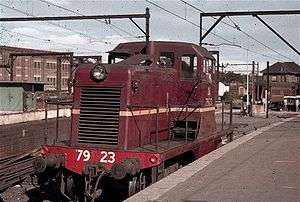New South Wales 79 class locomotive
| New South Wales 79 class | |||||||||||||||||||||||||||||||||||||||||||||||
|---|---|---|---|---|---|---|---|---|---|---|---|---|---|---|---|---|---|---|---|---|---|---|---|---|---|---|---|---|---|---|---|---|---|---|---|---|---|---|---|---|---|---|---|---|---|---|---|
|
7923 at Sydney Central | |||||||||||||||||||||||||||||||||||||||||||||||
| |||||||||||||||||||||||||||||||||||||||||||||||
| |||||||||||||||||||||||||||||||||||||||||||||||
| |||||||||||||||||||||||||||||||||||||||||||||||
| |||||||||||||||||||||||||||||||||||||||||||||||
Importation
In 1943, during World War II, four diesel-electric industrial shunting type locomotives built by General Electric Company, Erie for the United States Army Transportation Corps (USATC) were imported from the United States of America by the Department of Supply under Lend-Lease conditions for use at the Dunheved munitions factory in Sydney. They were four units of 58 units built for the USATC by General Electric numbered 8499-8528 & 7900-7929.[1]
Before entering service in New South Wales the 4 locos were fitted with buffers and hook drawgear to NSWGR standards. The cab profile was also altered to fit within the New South Wales loading gauge. It seems that only one unit was used at the Dunheved facility. Being of the hood type, with a central cab, they could work in either direction without turning.[2][3]
Operations


In 1945, the BHP became interested in the possible dieselisation at its Australian Iron & Steel works in Port Kembla and one unit was loaned to the company in April. Whilst it proved too light for the tasks of hauling ingots and ladles, it did lead to the commencement of dieselisation five years later.[4]
At the end of that war, they were put into use by the New South Wales Government Railways as shunters at Sydney Central station and Eveleigh Carriage Workshops. They were numbered 7920 to 7923, these being the numbers allocated by US authorities. In April 1948, the Commonwealth Government took 7921 and 7922 for use at Woomera Rocket Range and 7920 and 7923 were purchased by the NSWGR in September that year.
In 1950, the two owned by the Commonwealth Government were transferred to Commonwealth Railways as the DE Class and used as shunters at Port Augusta and Port Pirie.[5] In July 1975 both were included in the transfer of the Commonwealth Railways to Australian National.
Disposal & preservation
In October 1974 the two NSWGR units were sold to the British Phosphate Commission for use on Christmas Island. In 1979 both were rebuilt by FR Tulk, Perth with Caterpillar D3306 engines and lower profile noses.[6] This railway closed in 1987.
Following their retirement in the early 1980s, 7921 returned to New South Wales and is preserved at the New South Wales Rail Transport Museum, Thirlmere, while 7922 is with the National Railway Museum, Port Adelaide.[7][8]
References
Notes
- ↑ Allied Military Locomotives of the Second World War. Tourret Publishing. 1995. ISBN 0 905878 06 X.
- ↑ A Century Plus of Locomotives. Australian Railway Historical Society, New South Wales Division. 1965.
- ↑ The Early Diesel and Electric Locomotives of the NSWGR. New South Wales Rail Transport Museum. 1997. ISBN 9780909862527.
- ↑ Oberg, Leon (2007). Locomotives of Australia. ISBN 978-1-877058-54-7.
- ↑ Standard Gauge DE Chris' Commonwealth Railways Pages
- ↑ Oberg, Leon (1984). Locomotives of Australia 1850s - 1980s. Frenchs Forest: Reed Books. p. 174. ISBN 0 730100 05 7.
- ↑ DE-class Bo+Bo diesel electric locomotive No.91 National Railway Museum
- ↑ 79 Class Vicsig
Bibliography
- Fluck, Ronald E; Marshall, Barry; Wilson, John (1996). Locomotives and Railcars of the Commonwealth Railways. Welland, SA: Gresley Publishing. ISBN 1876216018.
- New South Wales Rail System Locomotives. Sydney: Archives Section, State Rail Authority of New South Wales. 1984.
